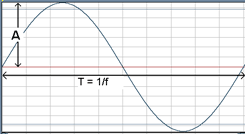
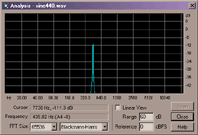
Sounddesign 101
Index
Analog synthesizers/synthesis concepts
Different approaches to sounddesign
This is text was as a response to countless questions appearing at triton central and tritonhaven regarding basic sounddesign and how to make sounds on the triton. There are comprehensive books about analog/digital sounddesign, acoustics, etc. If you are really interested (and motivated), I would advice picking up one of those. This guide is intended to be a "quick & dirty" introduction to the most fundamental concepts in making sounds on a subtracitve synthesizer.
For simplicity, I will use a basic analog synthesizer setup. Please understand that nearly all digital synths are variations of the same concepts. I have tried to stear away from unnecessary theory. In my view, you really dont have to have a degree in electronics or acoustics to make good sounds (although in some situations, it could be an advantage). Having a good ear and being musical is a lot more important.
Remember that most of the pictures will make a sound of you click them.
Sound is pressure differences travelling in a medium. The best analogy is ripples in a pond from a disturbance. Difference is, soundwaves generally travel in three dimentions, while waves in water of course travels in only two. However, the effects seen in a pond can be expanded to three dimentions (obstacles, interference etc). Commonly, the medium will be air.
A sound source is an object that cause pressure variation in air. This can be caused by a vibrating string, reed, lip, voice chord etc. Each of these have different characteristics. In addition, the properties of the vibrating object can be altered, causing a different sound. Also, various objects used in conjunction with the sound-generating object can alter the sound (the tube of a trumpet, the room, etc)
pic 1 Amplitude and frequency for a typical waveform (sine). Hint: click picture to hear what is going on.
pic2: frequency content of the same file
Amplitude say something about how big vibrations an object has. It also say something about the surface area of the vibrating object, and how efficient the coupling from object to air is. The deciBel scale used is logarithmic. Therefore, if the power of a signal is doubled, it is 3dB louder.
Give me more!The pitch of a sound. How fast an object vibrates in Hz (vibrations/second). Frequency is also specified using a logarithmic scale. The scale of a piano is divided into octaves. Each octave is double the frequency of the last. Using the equall tempered scale, the relationship between notes is kepth constant. Therefore, an equall tempered instrument can play music in any key with the same relationship between notes.
Give me more!pic 3-8: typical sawtooth, square and noise waveform with corresponding harmonics
In addition to vibrating with a certain amplitude and frequency, all waveforms except sines also have a harmonic content. Due to physical characteristics of the soundsource, overtones at different frequencies and amplitudes is mixed into the waveform. Harmonic overtones are multiples of the 1. harmonic. In-harmonic ones are (surprise, surprise :-) overtones that have a non-integer relationship to the 1st. If the 1st harmonic is moved around, all of the overtones are moved accordingly. Many sound sources also have non-pitched content. Examples of this are the sound of a guitar players plectrum, and the breath noise found in brass/wind instruments.
Shure, give me the hard factsThe result of the frequency content is a waveform. This can be a single-cycle geometric shape (sine,saw,square,triangular). It can also be more complex, long shape, speech for instance. Important waveforms are sines (only one harmonic), noise (infinite # of harmonics). Noise is the result of random values. Try looking at the waveforms and corresponding frequency analysis pictures. Try listening to the waveforms, comparing them to those of the sine. While these are mathematical waveforms not found in the nature, you might hear some similarities? The sine produce a very soft, dull tone, remiscent of humming. Square and saw waves make very bright, buzzy sounds that arent too pleasing to the ear. The saw might sound like some kind of brass instrument, while the square is quite like a clarinet? While the noise sounds like a waterfall, or a big crowd. Note that while the sine/saw/square waveforms have (one or more) obvious vertical lines (distinct frequencies), then noise waveform have none. Rather, all frequencies seem to be about equal. This will be of use later on.
Synthesizers are in many ways modelled after the physical world of sound, but with the limitations of hardware and user input. The first synthesizers used pure analog circuitry and had all functions hardwired to front-panel knobs and switches. For many years, there was no way to save patches, and the maximum #of sounding notes(polyphony) was 1!
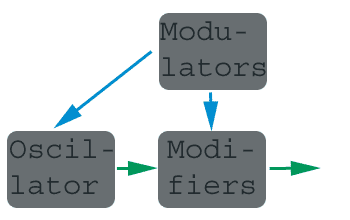
pic 9 an over-simplified model of an analog synth. Green arrows represent audio, while blue represent control
Sound generators (oscillators)
One or a few analog oscillators make very simple waveforms (typically saw and square ). The pitch of that oscillator can be changed by different means. Keyboard, pitch wheel, knobs and different internal modulation sources, all change the pitch if desired. In addition, a few parametes can be specified on the front panel, coarse and fine tuning, amplitude being the most important.
In addition, many analog synths have a noise generator. This usually have only a level control.
Traditionally, there are two basic sound modifiers, VCF and VCA. Sometimes called DCF/DCA or TVF/TVA.
The voltage controlled amplifier is basically an amplitude modifier. A controller input is used for specifying the degree of amplification wanted.
The voltage controlled filter is a unit for altering the frequency content of a waveform. The most common type, lowpass filter(lp), is a filter that removes all frequencies above a specified frequency, the cutoff frequency (fc). In most synths, the frequencies near the fc can be boosted using a button called Q or resonans. If this dial is set high enough, a ringing tone can be heard at the fc. Other filter types are highpass (hp), bandpass (bp), bandcut (bc), notch, comb, etc. The lp/bp/hp are most common in synths.
Inputs are provided for altering the fc and, sometimes, the q level in real-time.
Pic 10: scetch of a lowpass vcf (filter) with cutoff frequency Fc and resonans/q. C lick to hear a sawtooth wave applied to a lp filter 1st witout any res., then with massive res.
The mp3 file is quite large (coded at 320kbps because the file didnt like mp3 too much). Notice how the resonant filter "picks out" the last harmonics quite noticeably. Got to the picture of harmonics in a saw wave to see those depicted.
Aw yeah. Hit me!In order to create evolving sounds, and sounds with a lot of user control, some kind of modulation is needed. Modulation sources does not make sound itself, they rather hook up with the modulation inputs of sound generators and sound modifiers to change the way that those make/alter sound. Some modulation sources are actually a part of the user interface, such as the pitch wheel, pedals etc. Other are inside the synthesizer. In addition, a modulation source can be applied to another modulation source (an example of that would be the mod wheel controlling how much lfo is applied to pitch. more on that below). It soon becomes evident that the possibilities are endless, and manufacturers have taken different approaches to how much control the user get.
The very first synthesizers, modular monsters, used one box for each function. Those boxes had to be interconnected by wires, so the user could pretty much design the synthesizer himself (even buy the kind of modules that he fancied). the backside would be, of course, that rather than spending 2 minutes setting up a patch from paper (!), one had to spend maybe 10s of minutes. A little impractical on stage (hey, we have to take 15mins off while the synthesist wires up the sound for the next song). A related approach was the prewired/semi modular synths. These had preset "wires" for all or some functions, while all/some of those could be overridden by a patch panel. Also, matrix modulation is a software way to accomplish essentially the same.
Two basic modulation generators are found on nearly all synths, envelopes and lfos.
An envelope is a shape that is generated each time a note is struck. Generally, the user is given a number of values that control the time from state to state, and the level of that sate. Common modulation inputs are time scaling and hardwired key scaling (envelope behaves differently according to note#).
pic 11a)-c): a saw waveform a)nonmodulated, b)amplitudemodulated and c) pitchmodulated. All by a standard ADSR envelope. Pics are with a very low frequency waveform for illustration purposes, the audio files are at a much higher frequency compared to the envelope times.
As you may see, the waveform in picture 11b) have a amplitude shape like that of the typical ADSR envelope. While picture 11c) have closer oscillations at the same spot where 11b) have its peak. This is where the pitchmodulation is at its highest. This same setup could have been used to illustrate a filter modulated by envelope as well, but it would be more difficult to see, as the wavshape would only be more rounded at the "low levels" and unchanged at the envelope peak.
An lfo is a cousin of the sound generating oscillators. Difference is, lfos generate controller signals, not audio. In most instruments, the maximum frequency is below the audio range. Usually, the user can choose from different waveforms. Also, the frequency and amplitude can be altered. Some advanced lfos allow delay, fade-in and other parameters (essentially, a simple envelope is applied to the lfo). Modulation inputs most commonly are frequency and amplitude.
pic 12a) and b) A saw waveform a)nonmodulated and b) pitchmodulated by an lfo with a sine waveform.
As shown in the pictures, waveforms modulated by an lfo are contiously modulated, while envelope modulation run through a set of stages, then finishes off. There are more to be said about modulation. Very highfrequency lfos (kind of a contradiction :-) Can cause a buzzy signal (AM) that is difficult to achieve on digital synths.
Just to complicate things, some envelopes are actually lfos, and some lfos have built-in simple envelopes! This is not very important, but certain synths have loopable envelopes, thereby allowing you to create a lfo waveshape of your own. Most digital lfos have parameters that control how much modulation is applied over time, this could have been accomplished by inserting an envelope at the amplitude input of an lfo.
We now have the tools needed to understand a fairly powerful synth, along the lines of that shown in pic 13. One to four oscillators generate a separate waveform at a pitch determined by modulators and keyboard input. These modulators can be envelopes or lfos, with a whole range of parameters. Moreoverover, modulators can modulate other modulators, using preset paths, or a modulation matrix. The modulators are also used to alter the parameters of the modifiers, vcf and vca, before the sound is passed on to the output (or to internal mixing/fx processing, more on that later).
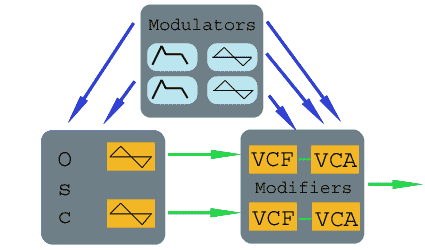
pic 13: A more complete synth structure, containing two oscillators, envelopes, lfos, vcf and vcas. A general control-flow routing is outlined, this could be matrix modulation, or a number of preset routings.
Special features of analog synths
Pulse width modulation (pwm, found in oscillator section). Can only be used on square waves. A square consists of 1/2 period of +A and 1/2 period of -A. By variying the relationship between +A and -A, the pitch is unaltered, while the harmonics are altered in a way filters cannot do. Put to great use in classic analog string pads (modulated by lfo for a chorus-like effect).
Oscillator sync (oscillator section). One oscillator is defined as the master, the other as a slave. If both are set to the same pitch, nothing happens. But when the pitch is different, the waveform of the slave oscillator is retriggered each time the master oscillator complete a cycle.
Sample & hold. This is a "digitizer". Apply a smooth waveform in, and you get a stepped waveform out. Used to great effect on lfo waveforms.
Ring modulator. more of an effect, really, but since it is present in so many analog synths, I have placed it here. Two inputs are needed, and the output represent the difference between input 1 & 2, producing a ringing/metallic/unharmonic sound, provided that input 1 & 2 are different.
Drifting. Due to the temperature dependence of analog components, it is impossible to make them 100% accurate. Moreover, different parts of the synth may react differently to temperature changes, and may be calibrated differently. Consequently, two oscillators set to the same pitch, will always play slightly out of tune. They may also play more in tune on certain parts of the keyboard than others. This was considered a fault in the old days, and designers went to great lengths to avoid them. Today, many "vintage fans" consider this a great
Envelope shape. Due to capacitor discharge, envelopes of analog synths are commonly logarithmic shaped instead of linear. (sharkfin-shaped insetad of a triangle). This, of course, give a different sound. Also, all parameters occur continually, at all times. Therefore, certain sounds may sound differently on true analog synths.
Different analogue/semi-analogue synths
There are several types (and generations) of analogue synths. The very first was modular monsters of 100kg or more, with big price tags (ca. 1965 and on). Later came smaller versions with less flexibility, but more "roadability" (minimoog ca. 1971). Synths were still monophonic and memory less. The first true polyphonic and memory equipped synths came in the late 70`s (sci prophet 5). This generation of synths was often called "digitally controlled analog synths". In the eighties came hybrid analog/digital synths featuring a mix of analog and digital components (Roland jx-series, Oberheim matrix 6)
Today, nearly all synths sold are digital. There are several reasons for this. They are less expensive to manufacture, more reliable, can have lots of functions etc. Nearly all are direct descendants of the minimoog modell outlined in the previous chapter. Difference is, those functions are done in a digital circuits, either in special dsp circuits in combination with a specialized computer, or on a pc/mac platform running in software.
One of the Important differences between digital and analog synths lie in the oscillator department. While analog synths can make very pleasing simple waveforms, digital synthesis can make extremely complex waveforms at the oscillator level, before any processing is done. The argueably most important synthesis method today, judging by number of synths in use, will probably be the sample + synthesis (s&s) model popularized by Rolands D50 and Korgs M1 synths/workstations. These have two (or more) digital oscillators playing back wavetables from a huge memory. These wavetables can be samples of any sound or instrument wanted, or digitally generated waveforms (generated beforehand, not on the fly as in VA synths. The difference will be explained). A key to the quality of such a synth is, of course, the quality of the onboard samples, and therefore, a lot of work goes into making them as good as possible, while keeping them small enough to fit into low-cost memorys. Problem is, everyone using a certain make of synths, are using the same samples, and, in many cases, the same presets! Also, samples tend to "wear out" as a result of this. The solution is synths with replaceable/upgradeable samples in the form of rom cards, sample ram, or similar. Or synths with powerful synthesis functions that liberate the user from the sample as main ingredient of sound.
Samplers use the same setup, except their waveforms can be created by the user.Recently, the difference between wavetable synths and samplers have been blurred, as samplers have gotten more and more "synthesis" functions (and even built-in rom waveforms), while synths have gotten sample ram for loading samples from disk, or even full-blown built in samplers (kurzweil k2x00, yamaha ex-series, korg tritons)
other breeds of digital synths
The recent Virtual Analog(VA) craze are digital synths trying to recreate all characteristics (and often the "flaws") found on old analog synths, while sometimes adding new functions.
Other digital synthesis types are:
Early wavetable generation. Synths like the ppg wave/waldorf (micro)wave used strings of wavetables containing small snips of audio or waveforms. The interesting part is that the waveform itself is subject to modulation, so depending on the set used, a range of interesting sounds can be made. The Korg wavestation use a similar approach, where a string of waveforms can have separate pitch and amplitude to form a wavesequence. This can produce cheesy autoaccomp sounds, or sweeping contious sounds.
Vector synthesis. Introduced with the sci prophet vs. Different sounds or waveforms are assigned to each corner of a joystick diamond. The joystick can be used live, or its motion recorded as a two-dimentional envelope. Also present in Korg WS and Yamaha sy22/33.
Fm synthesis (yamaha dx7) using simple sines to modulate the frequency of other sines, dynamic and powerfull sounds can be achieved that are difficult with any other synthesis. Especially rhodes/marimba types of sounds seems to lend itself to fm generation.
Additive synthesis is a relative of fm. Instead of modulation, sound is generated by a massive amount of sines (32 or more). Given a good model of the frequency content of a given sound (and a lot of patience), any sound can be duplicated given a sufficient #of sines.
Physical modelling. Use complex physical/mathematical models of the entire instrument instead of snapshots(samples) or approximations into the subtractive model. Conseptually, any real-world instrument can be imitated by physicall modelling, but the best simulations so far have been reed, brass and analog synths (Yamaha Vl-1 and Korg Z1/moss)
Digital synths use digital circuitry running on a specified clock-rate. Depending on the configuration, this can cause signal degradation. Early digital synths used low sample-rates and bit resolution. As a consequence, sound was distorted and lacked high-frequency content. Today, all synth have "cd-quality" 16bit/44.1 khz signal paths or better, but this alone isnt enough to enshure high quality. The design of filters, cpu power, etc affects sound quality and timing.
As digital synths have a lot more functions than analog ones, there isnt room for knobs/buttons for all of them on the front panel. Therefore, a computer-like system of display and a few buttons can be found on most digital synths. Some synths (esp VA) have some buttons for the most common sound-editing functions, or dual-function knobs/programmable knobs.
Today, most synths have one or several built-in fx engines. These are vital to creating interesting sounds. Most synth presets use fx processing suited for soloing the sounds. This may work well for trying a synth in the store (where most people decide what synth to buy), but on a stage or on tape, those sounds may have to be edited. In addition, most synths cannot apply as much power to each part in sequencer mode as they can in program mode.
There are several types of effects in use, I will only mention the most common ones.
Common parameters for all fx are wet/dry mix. This specifies the ratio of effected to original signal that is output.
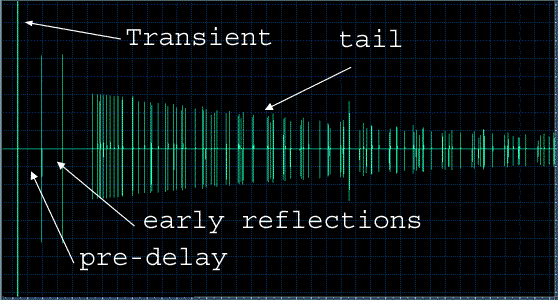
Typical reverb
Perhaps the most important effect, and one of the few effects that actually exist in real-life. Reverb can be described as the "sound" of a room, church, arena or whatever. This is often reflected in the name of each reverb algorithm. Some reverbs are models of other models of reverb, such as "plate" and "spring", modelling the sound of, respectively, old plate reverbs used in studios and the spring reverb found in guitar amplifiers. Other algorithms often found is the reverse reverb, mimicing the sound of a reverb recorded and played backwards, and gated reverb, which is a reverb with the tail chopped off.
Parameters: pre-delay: the delay before any sound, reverb-time/decay-time: the length of the reverb tail, high-damping: how fast high frequencies die out.There are often some filter/eq settings for tailoring the "boomines" of reflected sound.
Tell me more about time-based fx

Delay with feedback (regular spaced echoes), multitap delay (irregular spaced echoes)
Related to reverb, but consisting of distinguishable echoes. There are several variation. Simple delay repeats the input sound a specified number of times (feedback) at regular spaced intervals. Tempo delay lets you specify delay time in note durations or controlled by midi time(or a tap button).Multitap delay consist of several delays in series, allowing irregular delay times. Modulation delay allows the delay time to be modulated by a modulator.
Parameters: delay time (one or more), tap pan (pan different delays differently), feedback (controls how many repeats you will get)
These are fx that only partially exist in the real world. By modulating the pitch/phase of the signal and mixing this with the original signal, these effects can be accomplished. Chorus/ensemble vaguely mimic the sound of two analog oscillators slightly out of tune, or the effect of several players/singers "trying" to play the same notes. Flanger mimic the sound of touching the tape of a analog tape deck while playing, to make a wooshing sound. Phasers sound similar.
Parameters: delay time, frequency (the lfo frequency for chorus).
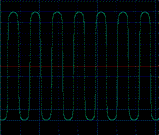
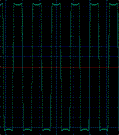
soft overdrive, and full distortion
Simlate the sound of a distorted amplifier or pedal. Can add a slight "grit" to organ/rhodes sounds that make them stand out better in a mix.
Parameters: amount
Lets you boost or cut specified frequencies. Parametric eqs lets you specify what frequencies and how broad a frequency band to attenuate.
Dynamics (gate/compressor/limiter)
Used to even out the amplitude of a track (compressor), lower strong parts (limiter), or remove parts that are weaker than a specified treshold level (gate).
Different approaches to sound design
Depending on application and equipment, there are several methods for making sound, just as there are different approaches to making music.
If you have a sampler, you are pretty much dependent on the source you are sampling. If you are sampling a piano, you will save a lot of work (and get better results) by carefully choosing the best piano you can get your hands on, and getting it tuned up. Also, all techniques for recording a piano to tape equally applies to sampling it. As with a lot of the stuff presented here, one could probably write books about recording piano alone, but that would be out of scope for this article. I will simply point out: try recording the piano directly to tape while playing various genres of music, and listen closely to the tape. Is the L/R balance right? What about the low/high key balance? Be careful when using multiple mikes not to get weird phase cancelation problems. Be aware that this stuff can be difficult to hear in a less than perfect listening situation (and with little time). Also, try to decide what to do beforehand. A little planning can save you hours of redoing work.
There are several approaches to sampling. The purist approach involves sampling "what you hear" and trying to do as little as possible to the sound afterwards. Another approach is identifying the limitations of a sampler, and trying to harness the sound in a way that minimize those limitations. This can be done by compressing the sound before digitizing it, then trying to recreate the real envelope using the synth functions of a sampler/sampling synth. For a piano, the top notes played at low velocity may be many dB weaker then the low notes played at high velocity. By compressing and/or compensating the microphone gain, you may achieve true 16bit sound at those weak notes, while the "purist" approach may give only 13 or 14 bits. On the other hand, you will have to trust your ears or measurements to get the true amplitude relationship and amplitude envelope.
Acoustic/real sounds typically alter the characteristics when played harder, or at another pitch. IE, other parameters than amplitude change as the velocity is increased, and other parameters than pitch change as different notes are played. In theory, this behaviour could probably be faithfully recreated by an infinetely complex filter where all frequencies and corresponding amplitudes tracked key # and velocity independently. Of course, such a filter is impossible (or impractical) to produce. Therefore, a combination of filter/envelope/tracking approximation AND multiple samples taken at different keys/velocities are most common.
Due to the limitations of sampler memory, long sounds may have to be looped to conserve memory. Drum loops are a very good example of sounds that can safely be looped (in fact, looping is part of the style), and sampling a 2min30s loop would be a waste of memory, if it never change. Many instrument sounds can be looped as well. The art (yes, art, as it is not an exact science, rather the result of experience) of looping a sample, consists of finding a portion where the amplitude and sound characteristic remains as constant as possible, and finding points where "loop clicks" cannot be heard. xfade looping helps out, but still one have to use the ears to get good results.
One common trick for simulating the attack of certain brass instruements: use a short pitch envelope starting at a very small or high value. Set it to a short decay time, and let it return to zero afterwards. Then modulate +pitch of one oscillator, and -pitch of the other in a two-oscillator sound (set all other parameters fairly identical).
To be continued...